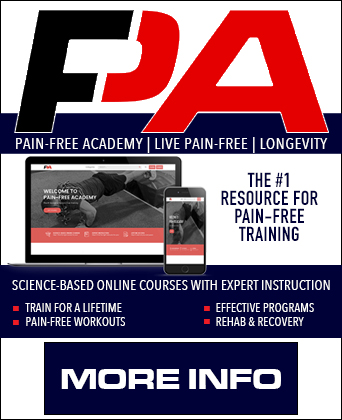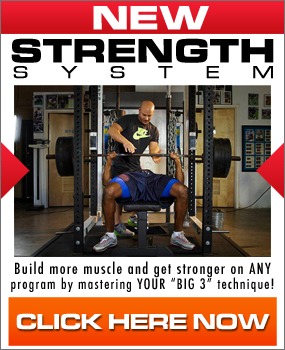Pressing Considerations for the Older Lifter – Part 4

Pressing Considerations for the Older Lifter
Part 4
We will now finish the 4-part of the Pressing Considerations for Older Lifters article series. As you have probably guessed, all of these innovative strategies are beneficial for anyone, not just those who have been training for many years. The ultimate goal of the series was to show you that, independent of your current goals and your individual limitations, there is always a way to train.
Not only train, but train with great intensity.
As a quick recap, in Part 1 of the series we talked about warming up and improving mobility. In Part 2, we transitioned into re-establishing tension through the full range of motion for bench pressing and then moved into neutral grip and thick bar pressing with Part 3.
In today’s article, we will focus on 3 excellent tips for improving your pressing potential.
The Slingshot
The Slingshot is an invention created by Mark Bell. Mark is a powerlifter and the owner of Supertraining Gym in CA. He also created POWER! magazine, which I have written articles for in the past.
The Slingshot is created out of the same material as wrist wraps or knee wraps, but it is much bigger. In a nutshell, it is a very easy-to-use version of a bench shirt. It assists you by providing elastic assistance in the hole (off your chest) with the bench and it takes strain off of your elbows and shoulders. When you’re at your weakest, the Slingshot steps in to assist and when you’re at your strongest, it comes off tension.
We use the Slingshot a lot with novice or detrained clients or young athletes. You can get a ton of pressing volume without the associated strain associated with restricted barbell benching. It also provides a great transition into the full execution of the lift or when you’re coming off an injury.
To increase your work capacity and GPP, the Slingshot is also great for repetitive effort work (many times replacing dynamic effort work when your CNS is run down) when performing sets with repetitions greater than 12+ or for high repetition push-ups sets.
Shoulder Safe Dumbbell Spot
In the following video, I show you the top 3 ways to start your dumbbell bench press set. If you have shoulder issues or are unstable on the first repetition, you can use the second or third variation as demonstrated in the video. When I go heavy, I like to use the 3rd variation exclusively. Because many times you’ll see a lifter go for a heavy set, but end up grinding in the bottom trying to get the first rep up. With the third technique, you’ll always start and end in a good strong and safe position.
Elevated Feet
In all of our pressing tips up to this point, we’ve focused exclusively on the upper body. In this final modification, we will talk quickly about the impact of the lower body on pressing strength and setup.
Older lifters are always fighting hip immobility. In fact, it is a daily struggle. They’ve had 15-20 years in the workforce and spent too much time sitting in traffic. Because of this lack of hip mobility, many times they can not get a good setup on the bench without stress or strain on their lower back. The movement that should be happening at the hips is forced and directed to the low back (lumbar region) – which structurally, has a limited range of motion.
But the low back pain you’re experiencing might not be a hip mobility issue – maybe you’ve had a back injury. For example, let’s look at Joe DeFranco. Joe has a back issue and has reoccurring back pain. So when he bench presses, he using this simple modification that I am about to show you.
Elevating your feet by placing them on a step or Olympic plate is a fast way to alleviate stress and strain on your lower back by lessening your arch when you set up on the bench. I have spoken about the required “full body tension” for the bench press in my How to Bench Press article (best on the NET) – and how the bench press is a full body lift. If you can not drive your feet downward during the press, you will be leaving weight on the table and creating an “energy leak” for your strength and power potential. Raising your feet up will help you re-establish proper tension and a good, solid setup – while you continue to work on your hip mobility in your program.
I hope you enjoyed this article series. Please share with your friends and family across Facebook and Twitter.
Smitty
See the other articles in the series:
Pressing Considerations for the Older Lifter – Part 1
Pressing Considerations for the Older Lifter – Part 2
Pressing Considerations for the Older Lifter – Part 3
Pressing Considerations for the Older Lifter – Part 4
By Smitty on April 3rd, 2012
FREE DIESEL NEWSLETTER
- Discover Pain Free, Joint-Friendly Training
- Get Super Effective Workouts and Programs
- Inspirational Life Lessons Each Week
- Effective Habits For Busy Entrepreneurs
















Smitty as always great stuff! At 57 and one surgically repaired shoulder and years of use and abuse I use all three of those tips! Good stuff!!
Thanks Mck12, I appreciate it!
Hi, Thanks for those great tips about Dumbell Bench Press,much Appreciated Dumbells are also a lot safer if you get into difficulty pressing.